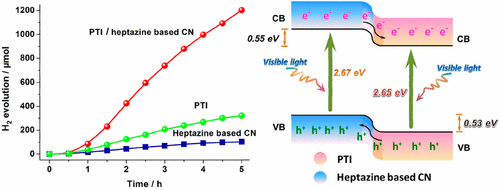当前位置:
X-MOL 学术
›
J. Phys. Chem. C
›
论文详情
Our official English website, www.x-mol.net, welcomes your
feedback! (Note: you will need to create a separate account there.)
Efficient Photocatalytic Hydrogen Evolution on Band Structure Tuned Polytriazine/Heptazine Based Carbon Nitride Heterojunctions with Ordered Needle-like Morphology Achieved by an In Situ Molten Salt Method
The Journal of Physical Chemistry C ( IF 3.3 ) Pub Date : 2017-09-22 00:00:00 , DOI: 10.1021/acs.jpcc.7b07243 Ailing Jin 1 , Yushuai Jia 1 , Changfeng Chen 1 , Xin Liu 1 , Junzhe Jiang 1 , Xiangshu Chen 1 , Fei Zhang 1
The Journal of Physical Chemistry C ( IF 3.3 ) Pub Date : 2017-09-22 00:00:00 , DOI: 10.1021/acs.jpcc.7b07243 Ailing Jin 1 , Yushuai Jia 1 , Changfeng Chen 1 , Xin Liu 1 , Junzhe Jiang 1 , Xiangshu Chen 1 , Fei Zhang 1
Affiliation

|
Polymeric carbon nitride (CN) is a fascinating metal-free photocatalyst for active solar energy conversion via water splitting. However, the photocatalytic activity of CN is significantly restricted by the intrinsic drawbacks of fast charge recombination because of incomplete polymerization. Herein, an in situ ionothermal molten salt strategy has been developed to construct polytriazine/heptazine based CN isotype heterojunctions from low cost and earth-abundant urea as the single-source precursor, with the purpose of greatly promoting the charge transfer and separation. The engineering of crystallinity and phase structure of CN has been attempted through facile tailoring of the condensation conditions in a molten salt medium. Increasing the synthetic temperature and eutectic salts/urea molar ratio leads to the formation of CN from bulk heptazine phase to crystalline polytriazine imide (PTI) phase, while CN isotype heterojunctions are in situ created at moderate synthetic temperature and salt amount. As evidenced by the measurements of UV–vis DRS and Mott–Schottky plots, the conduction band potentials can be tuned in a wide range from −1.51 to −0.96 V by controlling the synthetic temperature and salt amount, and the apparent band gap energies are reduced accordingly. The difference in band positions between PTI and heptazine phase CN enables the formation of CN heterojunctions, greatly promoting the separation of charge carriers. These metal-free CN heterojunctions demonstrate a well ordered needle-like morphology, and the optimal sample yields a remarkable hydrogen evolution rate (4813.2 μmol h–1 g–1), improved by a factor of 12 over that of bulk heptazine-based CN and a factor of 4 over that of PTI. The enhanced photocatalytic performance can be directly ascribed to the synergistic effect of the improved crystallinity with reduced structural defects, the decreased band gap energy with tunable band positions, and the efficient separation of charge carriers induced by the formation of heterostructures.
中文翻译:

原位熔盐法在带结构调整的聚三嗪/庚嗪基氮化碳异质结上形成有序针状形态的高效光催化氢演化
聚合氮化碳(CN)是一种引人入胜的无金属光催化剂,可通过水分解进行主动太阳能转化。但是,由于聚合不完全,快速电荷重组的固有缺点极大地限制了CN的光催化活性。本文中,已经开发了一种原位电热熔融盐策略,以低成本和富含土的尿素作为单源前体来构建基于聚三嗪/庚嗪的CN同种异质结,以大大促进电荷转移和分离。通过对熔融盐介质中的缩合条件进行简便的调整,已经尝试了CN的结晶度和相结构的工程设计。合成温度和共晶盐/脲摩尔比的增加导致CN从本体庚嗪相到结晶聚三嗪酰亚胺(PTI)相的形成,而CN同型异质结是在中等合成温度和适量盐的条件下原位生成的。如通过UV-vis DRS和Mott-Schottky图的测量所证明的,通过控制合成温度和盐量,可以在-1.51至-0.96 V的宽范围内调节导带电势,并且表观带隙能为相应减少。PTI和庚嗪相CN之间的能带位置不同使得能够形成CN异质结,从而大大促进了电荷载流子的分离。这些不含金属的CN异质结表现出井井有条的针状形态,–1 g –1),比基于庚烷的大部分CN提高了12倍,比PTI提高了4倍。增强的光催化性能可以直接归因于以下效果的协同效应:具有降低的结构缺陷的改善的结晶度,具有可调带位置的带隙能量的降低以及由异质结构的形成引起的电荷载流子的有效分离。
更新日期:2017-09-22
中文翻译:

原位熔盐法在带结构调整的聚三嗪/庚嗪基氮化碳异质结上形成有序针状形态的高效光催化氢演化
聚合氮化碳(CN)是一种引人入胜的无金属光催化剂,可通过水分解进行主动太阳能转化。但是,由于聚合不完全,快速电荷重组的固有缺点极大地限制了CN的光催化活性。本文中,已经开发了一种原位电热熔融盐策略,以低成本和富含土的尿素作为单源前体来构建基于聚三嗪/庚嗪的CN同种异质结,以大大促进电荷转移和分离。通过对熔融盐介质中的缩合条件进行简便的调整,已经尝试了CN的结晶度和相结构的工程设计。合成温度和共晶盐/脲摩尔比的增加导致CN从本体庚嗪相到结晶聚三嗪酰亚胺(PTI)相的形成,而CN同型异质结是在中等合成温度和适量盐的条件下原位生成的。如通过UV-vis DRS和Mott-Schottky图的测量所证明的,通过控制合成温度和盐量,可以在-1.51至-0.96 V的宽范围内调节导带电势,并且表观带隙能为相应减少。PTI和庚嗪相CN之间的能带位置不同使得能够形成CN异质结,从而大大促进了电荷载流子的分离。这些不含金属的CN异质结表现出井井有条的针状形态,–1 g –1),比基于庚烷的大部分CN提高了12倍,比PTI提高了4倍。增强的光催化性能可以直接归因于以下效果的协同效应:具有降低的结构缺陷的改善的结晶度,具有可调带位置的带隙能量的降低以及由异质结构的形成引起的电荷载流子的有效分离。











































 京公网安备 11010802027423号
京公网安备 11010802027423号